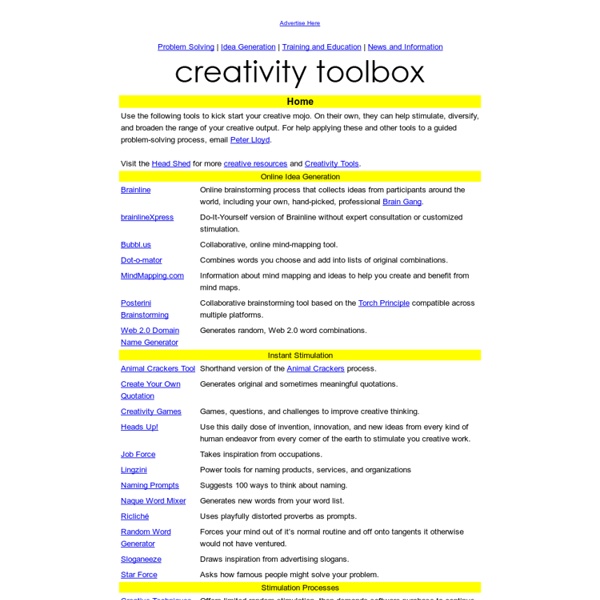



http://gocreate.com/tools/index.htm
Related: CreativityCreative Techniques This A to Z of Creativity and Innovation Techniques, provides an introduction to a range of tools and techniques for both idea generation (Creativity) and converting those ideas into reality (Innovation). Like most tools these techniques all have their good and bad points. I like to think of these creativity and innovation techniques as tools in a toolbox in much the same way as my toolbox at home for DIY. It has a saw, spanner, hammer, knife and all sorts of other things in it, they are all very useful, but you have to pick the right tool (creativity / Innovation technique) for each job. This site will try and provide a little guidance along with each tool to let you know whether it's best used for cutting paper or putting in nails.
Jump Start Jump Start continued... Did you enjoy this game? Then try Free the Genie Top News & Offerings MitchDitkoff.com Three Principles Behind All Tools || Take me back to the main ToolKit page || || Take me back to the DirectedCreativity Home page || There are many tools for creative thinking in the literature... Edward de Bono presents 13 tools in his book Serious Creativity Grace McGartland has 25 tips and techniques in Thunderbolt Thinking(TM) Arthur VanGundy covers 29 tools in Idea Power Michael Michalko describes 34 techniques in Thinkertoys Roger von Oech has 64 methods in his Creative Whack Pack Koberg and Bagnall give guidance on 67 tools in The Universal Traveler James Higgins tops them all with his book 101 Creative Problem Solving Techniques. Get Creative! Creative-Inspiring People, Places & Things on Creativity-Portal.com Home : Get Creative! Creative-Inspiring People, Places & Things We often find our richest sources of inspiration through our experiences with other people, places, and things. Here is a listing of sections on the Creativity Portal that will open the door of creative inspiration to you!
Copy and Share Documents with your Cell Phone Camera Conrad Hametner is passionate about globalizing technology and building forward thinking companies to address consumer and community needs. He has been called an “all-around executive athlete,” experienced in Marketing, Business Development and Operations. Conrad is also known by many foreign companies as “our man in the US” for his ability to launch technologies into US markets.
Creativity Processes, Creative Thinking and Lateral Thinking from MindTools © iStockphoto/pavlen The tools in this section can help you to become more creative. They are designed to help you devise creative and imaginative solutions to problems, and help you to spot opportunities that you might otherwise miss. Before you continue, it is important to understand what we mean by creativity, as there are two completely different types. The first is technical creativity, where people create new theories, technologies or ideas. 201 Ways to Arouse Your Creativity Arouse your creativity Electric flesh-arrows … traversing the body. A rainbow of color strikes the eyelids. A foam of music falls over the ears. It is the gong of the orgasm. ~ Anais Nin
The 37 best tools for data visualization It's often said that data is the new world currency, and the web is the exchange bureau through which it's traded. As consumers, we're positively swimming in data; it's everywhere from labels on food packaging design to World Health Organisation reports. As a result, for the designer it's becoming increasingly difficult to present data in a way that stands out from the mass of competing data streams. Get Adobe Creative Cloud One of the best ways to get your message across is to use a visualization to quickly draw attention to the key messages, and by presenting data visually it's also possible to uncover surprising patterns and observations that wouldn't be apparent from looking at stats alone. And nowadays, there's plenty of free graphic design software to help you do just that.
Pizza Pie Charts Pizza is an easy to use plugin. It's built with our responsive framework Foundation so you can quickly install it into your current Foundation project. Water BuffaloBisonSheepGoatShetland Pony PepperoniSausageCheeseMushroomChickenOther The Setup Using Google Charts - Google Charts Google Charts provides a perfect way to visualize data on your website. From simple line charts to complex hierarchical tree maps, the chart gallery provides a large number of ready-to-use chart types. The most common way to use Google Charts is with simple JavaScript that you embed in your web page. You load some Google Chart libraries, list the data to be charted, select options to customize your chart, and finally create a chart object with an id that you choose. Then, later in the web page, you create a <div> with that id to display the Google Chart.
Productivity Archives - Teaching In Higher Ed A couple of weeks ago, I was the mini workflow guest for the Mac Power Users podcast, episode 240. Katie and David were in rare form. It was David’s birthday and perhaps nearly the last episode he recorded prior to announcing that he was going solo with his law practice… Screencasting and Video Editing Software Highest Quality Recording ScreenFlow has the best screen recording available – whether you are recording multiple screens at once, or using retina displays. Built in Stock Media Library